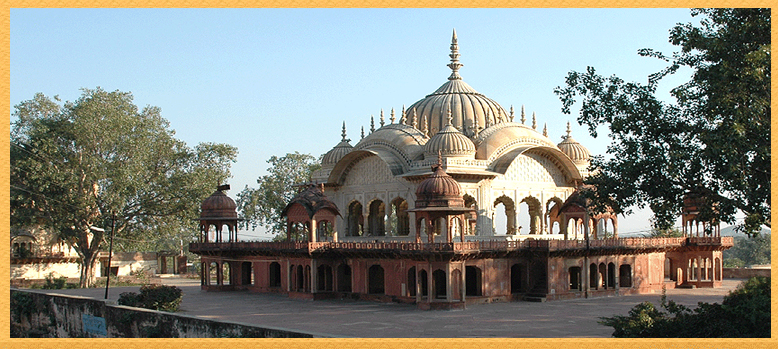160 kms from Delhi, 150 kms from Jaipur, Alwar is situated between the two major
centers in this part of the country.
As blinkered tourists and businessmen traverse, a massive ancient fort perched on a prominent hill, whispers tales of the rich history of the land. . Let's listen.
Once an ancient Rajput state, formerly known as Mewat, Alwar was nearest to the then imperial Delhi.
Proud, the populace did not accept any external interferences and stood up in arms against foreign invasions.
They even had the audacity to form a group and raid Delhi. But finally, Sultan Balban (1267 A.D. -1287 A.D.) Squashed them, bringing the entire area under Muslim rule.
In 1775 A.D., Maharaja Pratap Singh, a Kachchhwaha Rajput belonging to the clan of Jaipur rulers, won back Alwar and founded a principality of his own.
History apart, the city has a rich natural heritage. Serene Lakes, picturesque valleys, thick woods, flora and fauna that are a pleasure to the senses.
Some of the finest variety of birds and animals can be spotted here. Alwar has one of the best wildlife sanctuaries in Rajasthan - Sariska, the growling tiger country.
Places of interest:-
The Fort: This huge fort with its ramparts stretching 5 kms from North to South and 1.6 kms from East to West, stands 304 metres above the city and 595 metres above the sea level, constructed before the rise of the Mughal empire. Babar had spent a night at this fort and took away the hidden treasures to gift to his son, Humayun. Akbar's son, Jahangir also stayed here for some time during his exile. The place where he stayed is called Salim Mahal. The fort was finally annexed by Maharaja Pratap Singh in 1775 A.D.
It is a forbidding structure with 15 large and 51 small towers and 446 openings for musketry, along with 8 huge towers encompassing it.
The fort has severaI gates-Jai Pol, Suraj Pol,Laxman Pol, Chand Pol, Kishan Pol and Andheri Gate. Also there are remains of Jal Mahal, Nikumbh Mahal, Salim Sagar, Suraj Kund and many temples.
City Palace: An 18th century palace harmoniously blending the Rajput and Mughal styles of architecture. While the ground floors have been converted into government offices and district courts, the upper apartment is presently a Govt. Museum.
Government Museum: The museum has the finest collection of Mughal and Rajput paintings dating back to the 18th and 19th centuries and some rare ancient manuscripts in Persian, Arabic, Urdu and Sanskrit. 'Gulistan' (the garden of roses), 'Waqiat-e- Babri (autobiography of the Mughal Emperor Babar) and 'Boston' (the garden of spring) are some of the notable ones amongst the collection.
It also has a copy of the great epic 'Mahabharat' painted by the artists of the Alwar school.
A rich collection of the Indian armoury are among other exhibits of the museum.
Behind the City Palace is an artificial lake built in 1815 A.D. by Maharaja Vinay Singh with few temples along its banks. A marvellous chhatri with unusual Bengali roof and arches, also known as the Moosi Maharani Ki Chhatri,is situated in this area.
Purjan Vihar (Company Garden): A picturesque garden laid out during the reign of Maharaja Shiv Dan Singh in 1868. A.D. The garden has an enchanting setting called 'Shimla' which was built by Maharaia Mangal Singh in 1885 A.D. The lush surroundings and the cool shades make it the idyllic visiting spot during summers.
EXCURSIONS
Vijai Mandir Palace (10 km): A splendid palace, built by Maharaja Jai Singh in 1918 A.D. A picturesque lake overlooking the palace makes it a fascinating sight.
A fabulous Sita Ram Temple in the palace attracts number of devotees, especially during Ramnavami. One need prior permission from the Secretary to visit the palace.
Siliserh Lake and Palace Hotel (13 kms): An idyllic picnic spot with enchanting landscape of wooded hills and beautiful chhatris on the embankment of the 10.5 sq. kms. Placid lake. A magnificent royal palace and the hunting lodge built by Maharaja Vinay Singh in 1845 A.D. for his queen Sheela stands overlooking the lake. Now converted as the Hotel Lake Palace, it offers boating and sailing facilities and is a delight for the trigger-happy photographers and film-makers.
Jai Samand Lake (6 kms): A beautiful artificial lake constructed by Maharaja Jai Singh in 1910 A.D. is a popular spot for outings and picnics. During monsoons, sprawling greenery all around makes it a visual treat. Easily accessible by road from Alwar.
Sariska (37 kms) : The 765.80 sq. kms. thickly wooded reserve cradled in the picturesque valley of the Aravalis.Established in 1955, now an excellent tiger sanctuary under the Project Tiger. The dry deciduous forests of the Reserve are noted for their population of tiger, nilgai, sambhar, cheetal, four horned antelope and wild boar. The best time to drive in the sanctuary is from sunrise till sunset.
Sariska Palace: A marvellous palace was built here by Maharaja Jai Singh in honour of the duke of Edinburgh during his visit to the sanctuary. Presently, it has been converted into a hotel. RTDC Hotel Tiger Den also offers excellent accommodation at Sariska.
As blinkered tourists and businessmen traverse, a massive ancient fort perched on a prominent hill, whispers tales of the rich history of the land. . Let's listen.
Once an ancient Rajput state, formerly known as Mewat, Alwar was nearest to the then imperial Delhi.
Proud, the populace did not accept any external interferences and stood up in arms against foreign invasions.
They even had the audacity to form a group and raid Delhi. But finally, Sultan Balban (1267 A.D. -1287 A.D.) Squashed them, bringing the entire area under Muslim rule.
In 1775 A.D., Maharaja Pratap Singh, a Kachchhwaha Rajput belonging to the clan of Jaipur rulers, won back Alwar and founded a principality of his own.
History apart, the city has a rich natural heritage. Serene Lakes, picturesque valleys, thick woods, flora and fauna that are a pleasure to the senses.
Some of the finest variety of birds and animals can be spotted here. Alwar has one of the best wildlife sanctuaries in Rajasthan - Sariska, the growling tiger country.
Places of interest:-
The Fort: This huge fort with its ramparts stretching 5 kms from North to South and 1.6 kms from East to West, stands 304 metres above the city and 595 metres above the sea level, constructed before the rise of the Mughal empire. Babar had spent a night at this fort and took away the hidden treasures to gift to his son, Humayun. Akbar's son, Jahangir also stayed here for some time during his exile. The place where he stayed is called Salim Mahal. The fort was finally annexed by Maharaja Pratap Singh in 1775 A.D.
It is a forbidding structure with 15 large and 51 small towers and 446 openings for musketry, along with 8 huge towers encompassing it.
The fort has severaI gates-Jai Pol, Suraj Pol,Laxman Pol, Chand Pol, Kishan Pol and Andheri Gate. Also there are remains of Jal Mahal, Nikumbh Mahal, Salim Sagar, Suraj Kund and many temples.
City Palace: An 18th century palace harmoniously blending the Rajput and Mughal styles of architecture. While the ground floors have been converted into government offices and district courts, the upper apartment is presently a Govt. Museum.
Government Museum: The museum has the finest collection of Mughal and Rajput paintings dating back to the 18th and 19th centuries and some rare ancient manuscripts in Persian, Arabic, Urdu and Sanskrit. 'Gulistan' (the garden of roses), 'Waqiat-e- Babri (autobiography of the Mughal Emperor Babar) and 'Boston' (the garden of spring) are some of the notable ones amongst the collection.
It also has a copy of the great epic 'Mahabharat' painted by the artists of the Alwar school.
A rich collection of the Indian armoury are among other exhibits of the museum.
Behind the City Palace is an artificial lake built in 1815 A.D. by Maharaja Vinay Singh with few temples along its banks. A marvellous chhatri with unusual Bengali roof and arches, also known as the Moosi Maharani Ki Chhatri,is situated in this area.
Purjan Vihar (Company Garden): A picturesque garden laid out during the reign of Maharaja Shiv Dan Singh in 1868. A.D. The garden has an enchanting setting called 'Shimla' which was built by Maharaia Mangal Singh in 1885 A.D. The lush surroundings and the cool shades make it the idyllic visiting spot during summers.
EXCURSIONS
Vijai Mandir Palace (10 km): A splendid palace, built by Maharaja Jai Singh in 1918 A.D. A picturesque lake overlooking the palace makes it a fascinating sight.
A fabulous Sita Ram Temple in the palace attracts number of devotees, especially during Ramnavami. One need prior permission from the Secretary to visit the palace.
Siliserh Lake and Palace Hotel (13 kms): An idyllic picnic spot with enchanting landscape of wooded hills and beautiful chhatris on the embankment of the 10.5 sq. kms. Placid lake. A magnificent royal palace and the hunting lodge built by Maharaja Vinay Singh in 1845 A.D. for his queen Sheela stands overlooking the lake. Now converted as the Hotel Lake Palace, it offers boating and sailing facilities and is a delight for the trigger-happy photographers and film-makers.
Jai Samand Lake (6 kms): A beautiful artificial lake constructed by Maharaja Jai Singh in 1910 A.D. is a popular spot for outings and picnics. During monsoons, sprawling greenery all around makes it a visual treat. Easily accessible by road from Alwar.
Sariska (37 kms) : The 765.80 sq. kms. thickly wooded reserve cradled in the picturesque valley of the Aravalis.Established in 1955, now an excellent tiger sanctuary under the Project Tiger. The dry deciduous forests of the Reserve are noted for their population of tiger, nilgai, sambhar, cheetal, four horned antelope and wild boar. The best time to drive in the sanctuary is from sunrise till sunset.
Sariska Palace: A marvellous palace was built here by Maharaja Jai Singh in honour of the duke of Edinburgh during his visit to the sanctuary. Presently, it has been converted into a hotel. RTDC Hotel Tiger Den also offers excellent accommodation at Sariska.



